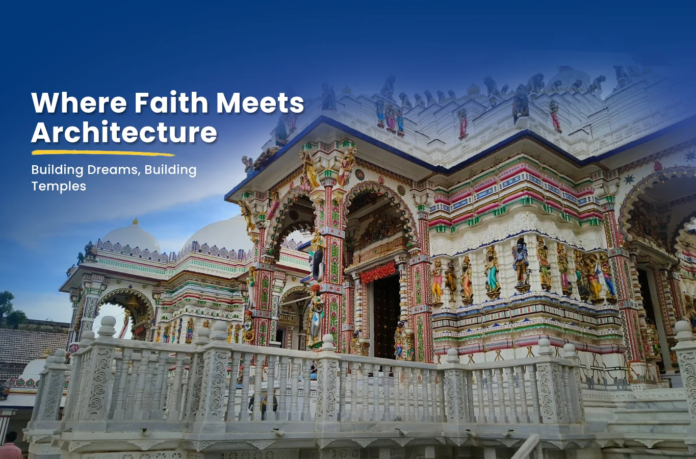Jain temples are celebrated for their intricate designs, serene ambiance, and spiritual symbolism. These temples, crafted by skilled artisans and architects, reflect the core tenets of Jainism while showcasing India’s architectural heritage. This article delves into the unique features of Jain temples, highlighting the contributions of temple architects in India, especially the Sompura artisans, and the role of temple construction services in Rajasthan.
The Significance of Jain Temple Architecture
Jain temples are not merely places of worship but embodiments of the Jain philosophy of simplicity, purity, and harmony. Their architecture symbolizes the path to liberation, emphasizing spiritual elevation and detachment from materialism.
Each element of a Jain temple, from its layout to its sculptures, is carefully designed to inspire devotion and inner peace.
Key Features of Jain Temples
1. Symmetry and Geometric Precision
One of the hallmarks of Jain temples is their symmetrical design. The floor plans are often based on geometric patterns, representing cosmic order. Precision is paramount, with every element meticulously aligned to maintain balance and harmony.
2. Intricate Stone Carvings
Jain temples are renowned for their exquisite stone carvings, depicting scenes from Jain mythology, floral patterns, and celestial beings. The Sompura artisans, known as master temple architects in India, are particularly celebrated for their expertise in stone carving. Their work on temples like the Dilwara Temples in Rajasthan showcases unparalleled craftsmanship.
3. Domes and Shikharas (Spires)
The domes and spires of Jain temples symbolize the ascent toward liberation. The Shikharas often feature intricate carvings, and their towering structure represents a connection between the earthly and divine realms.
4. Pillared Halls (Mandapas)
The Mandapas, or pillared halls, are a defining feature of Jain temples. These halls serve as gathering spaces for devotees and are adorned with intricately carved columns that narrate stories from Jain texts.
5. Sanctum Sanctorum (Garbha Griha)
The sanctum sanctorum houses the main deity, typically a Tirthankara idol, and is the spiritual heart of the temple. This area is designed to be serene and free from distractions, allowing devotees to meditate in peace.
The Role of Sompura Artisans in Jain Temple Design
Preserving a Timeless Craft
The Sompura artisans have been integral to the construction of Jain temples for centuries. This community of temple architects in India is renowned for their knowledge of Shilpa Shastra, the ancient Indian science of temple design.
Their work can be seen in iconic structures like the Ranakpur Jain Temple and the Dilwara Temples, where their attention to detail and mastery of carving bring the philosophy of Jainism to life.
Innovations in Traditional Craftsmanship
While staying true to ancient techniques, Sompura artisans have also adapted to modern tools and materials, ensuring that Jain temples remain relevant in contemporary times.
Temple Construction Services in Rajasthan
Why Rajasthan is a Hub for Jain Temples
Rajasthan is home to some of the most magnificent Jain temples in India. The region’s abundant supply of marble and sandstone, combined with the expertise of local artisans, makes it a natural hub for temple construction.
Key Services Offered
Professional temple construction services in Rajasthan ensure that every aspect of the temple-building process is handled with precision. These services include:
- Architectural Planning: Collaborating with Sompura artisans to create designs rooted in tradition.
- Material Procurement: Using high-quality materials like Makrana marble for durability and aesthetic appeal.
- Carving and Sculpting: Employing skilled artisans to execute intricate designs.
- Structural Engineering: Integrating modern techniques to enhance the temple’s stability and longevity.
Symbolism in Jain Temple Architecture
Reflecting the Philosophy of Jainism
Every feature of a Jain temple carries profound symbolism:
- The Shikharas represent the spiritual ascent to Moksha (liberation).
- The pillars and carvings depict the teachings of Tirthankaras, inspiring devotees to follow the path of non-violence and truth.
- The use of light and space within the temple symbolizes clarity and spiritual awakening.
Focus on Sustainability
Jain temples emphasize minimalism and sustainability, reflecting Jainism’s core principle of non-violence toward all living beings. This philosophy extends to the construction process, where natural materials and eco-friendly practices are prioritized.
Challenges in Building Jain Temples
Maintaining Traditional Practices
One of the challenges faced by Temple Architect in India is adhering to traditional methods while meeting modern requirements. For instance, incorporating facilities like parking and accessibility features into temple designs requires careful planning.
Sustaining Artisanal Skills
The skills required for intricate carving and temple construction are becoming rarer. Supporting and training future generations of artisans is essential to preserve this heritage.
The Future of Jain Temple Architecture
Integrating Modern Technology
While traditional methods remain central, modern tools like 3D modeling and CAD software are being used to refine designs and improve efficiency. These innovations help architects visualize complex patterns and ensure accuracy in execution.
Preserving Tradition in a Changing World
Despite the influence of modernity, the core principles of Jain Temple Sompura remain unchanged. By supporting skilled artisans and promoting sustainable practices, temple construction services in Rajasthan and across India are ensuring that these sacred spaces continue to inspire future generations.
Conclusion
The key features of Jain temple architecture—from their geometric precision to their intricate carvings—are a testament to the expertise of temple architects in India and the dedication of artisans like the Sompura community. Through the efforts of professional Temple Construction Service in Rajasthan , these timeless traditions are not only preserved but also adapted to meet the needs of modern worshippers.
Jain temples stand as enduring symbols of spirituality, craftsmanship, and cultural heritage, reflecting the harmonious blend of tradition and innovation.


